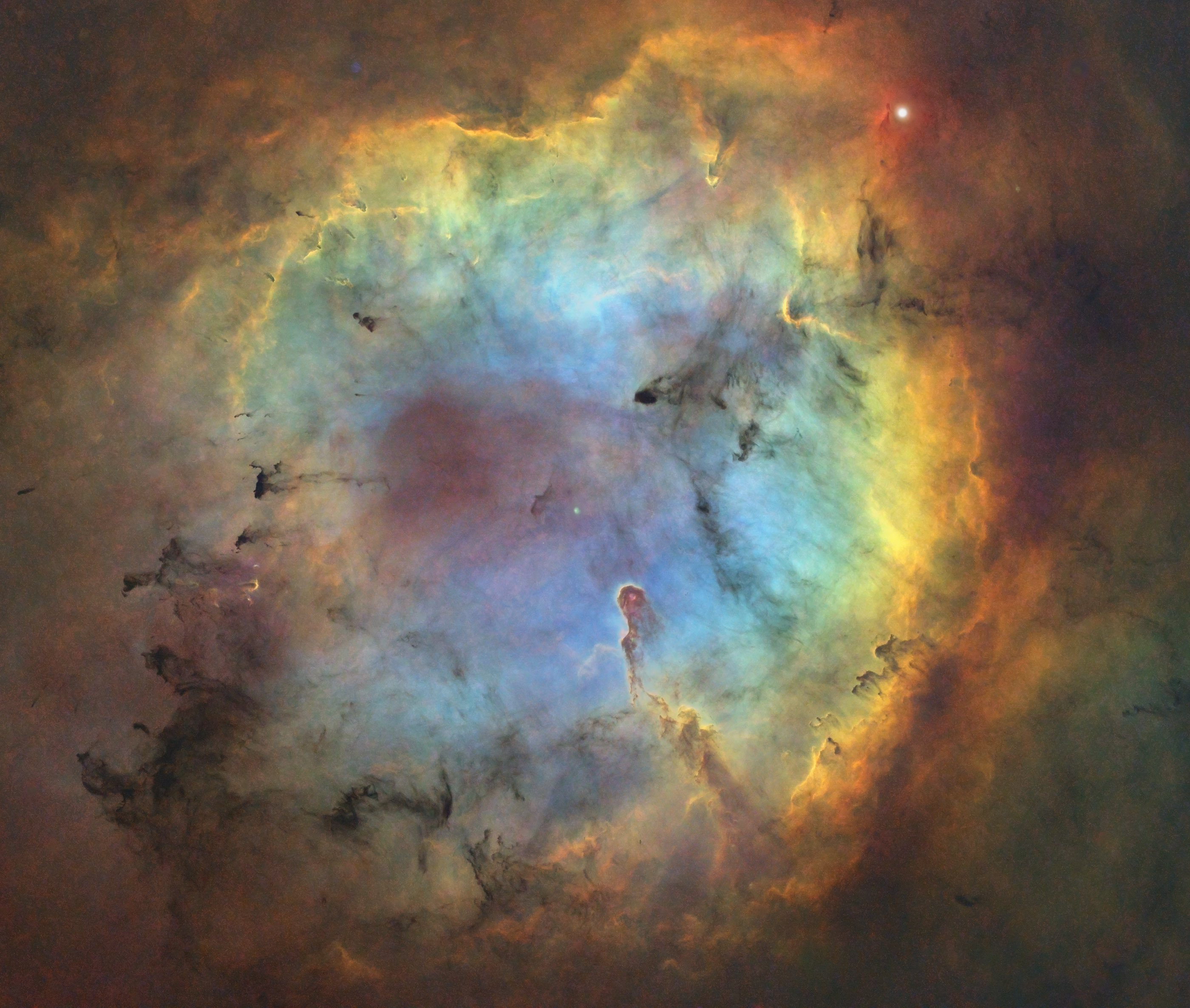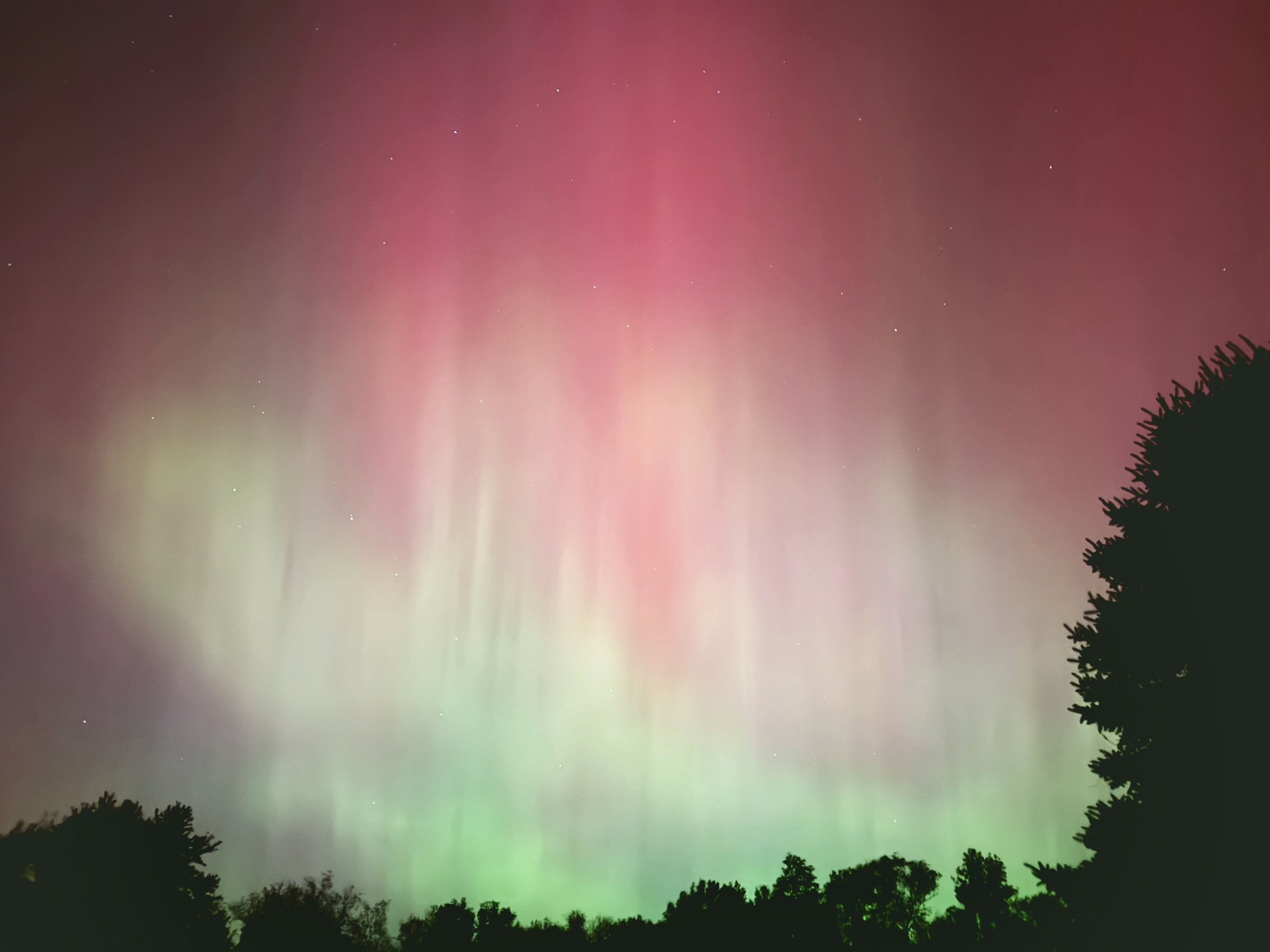IC1396 in Cepheus
The IC1396 Region with the Elephant's Trunk in HaOIIISII narrowband. The view from my backyard, given a specific set of equipment, time, and clear skies: around 60 x 300-second exposures for each of the 48mm Antlia 3nm Ha, OIII, SII filters, ZWO ASI2600MM-Pro monochrome camera cooled to -10C, William Optics Space Cat 51 apochromatic refractor (250mm FL @ f/4.9).
Posted October 26, 2024
October 2024 G4 geomagnetic storm
A spectacular night with the glow of the Aurora Borealis. This one came as a burst of energy across the sky that reached across the zenith and headed south. Ursa Major/Big Dipper at the lower left.
Posted October 11, 2024
Lunar imaging with a new camera
It's lunar photography tonight, with an 83% waxing moon. I'm out with the 8" Newtonian, 800mm FL at f/4 and the ZWO ASI715MC color camera. This is my first experience with the 715, so far so good, considering average atmospheric seeing--lot of turbulence up there. And these two are just single unstacked shots. I have a pile of SER files to process in AutoStakkert.

The Newt with the new ZWO 715:


Posted December 22, 2023
M78, LDN 1622, and a piece of Barnard's Loop
Top right is a structure composed of a batch of dark nebulae clustered around the reflection nebula Messier 78 (M78, NGC 2068), about 1,350 lightyears away, and bottom left is LDN1622, the "Boogeyman Nebula" about 500 lightyears away. And the wide ribbon running between them, mostly ionized hydrogen and interstellar dust, is part of "Barnard's Loop", which runs around the Alnitak side of the constellation Orion.
Imaging Notes: 49 x 300-second subs taken with the ZWO ASI071MC color camera (cooled to 0°C, gain 0) and the William Optics Redcat 51 apochromatic refractor (250mm FL, f/4.9), Sky-Watcher EQ6-R Pro mount, ZWO ASIAir Plus astro controller. I shot 94 sub-expsures at 5-minutes each, starting around 7pm and running through the night to about 4am, but ended up tossing almost half of them, stacking the best 49.
Posted December 20, 2023
Galaxies in Ursa Major
A wide-field view of Bode's Galaxy (M81, NGC 3031) and the Cigar Galaxy (M82, NGC 3034) about 12-million lightyears away in Ursa Major (the "Big Dipper"). There are a bunch of other galaxies in this view, including NGC 3077 and NGC 2976. The clouds and interstellar dust are in our galaxy and are lit by the surrounding starlight. Imaging Notes: 73 x 300-second sub-exposures taken with the William Optics Redcat51 apochromatic refractor, ZWO ASI071MC color camera cooled to 0°C at Gain 0.

Posted December 19, 2023
Just a typical night out with the astro gear!
Bortle 4-ish skies are great on a night when the upper atmosphere behaves, low altitude haze and fog are absent, and a new moon lines up reasonably well, but tonight is not that night. Take a look at the the haze around the large blue star (ν Andromedae) at the bottom of this single sub-exposure of Andromeda. I count 7 satellites running through this tiny rectangle of the night sky during this one five-minute exposure. What is also crazy is that guiding is actually pretty good, with a total error of 0.51 arcseconds. I don't know if those guiding numbers would have continued. I was hopeful when I first saw them. But after two exposures, I called it for the night. We have a Nor'Easter swinging through tomorrow afternoon, with an advance guard of clouds arriving tonight. I've packed things away, left everything setup and covered for a couple days. Hope everyone else has clear skies!

Posted December 16, 2023
M45, the Pleiades
The Pleiades, M45, also called the Seven Sisters, is a very bright and distinct open star cluster in Taurus, surrounded by the reflection nebula NGC 1432 (most of that pale blue interstellar dust and cloudiness). The Seven Sisters are very hot blue stars about 444 lightyears away. Where I am in the northern hemisphere, around 43° latitude, the Pleiades rises in the night sky in October, peaks in January at almost 50° in the southern sky, before sinking below the horizon by the end of March—and then we don't see it in the night sky again until late autumn.
To the ancient Greeks, over 2,500 years ago, the rising of the Pleiades marked the start of shipping season, when sailing the Mediterranean was a bit less dangerous. Like a lot of ancient mariners, Ancient Greek sailors and navigators relied on astronavigation, using the stars to determine their precise position on the surface of the earth. An ancient Athenian ship could leave the Piraeus and sail directly out to sea, then head west, toward Syracuse, tracking the stars the whole way to determine their course. They would also be keeping track of the Pleiades' position in the sky each night, and use that to determine if they should pick up cargo and make the return trip or pick up some local coastal work through the summer and return to Athens in the fall.
Imaging Notes: 71 x 5-minute sub-exposures stacked in PixInsight. ZWO ASI071MC color camera cooled to 0°C, Gain 0, Antlia V-Series Luminance/UV-IR Cut filter, William Optics RedCat 51 Apochromatic Refractor 250mm FL, f/4.9, Sky-Watcher EQ6-R Pro mount, ZWO ASIAir Plus astro controller.
Posted December 16, 2023
M42 Test with the new RedCat 51 and the ASI071 color camera
Well, that worked pretty well for an 88% waxing moon with the ZWO ASI071MC color camera. The near-full moon and Jupiter at opposition were just far enough away to make this set up work--plus a lot of 5-minute exposures. That band of red at the top left is the tail end of the ridge of hydrogen that runs behind the Horsehead Nebula (B33). Imaging notes: 63 x 300-second subs, no filters with the ZWO ASI071 color camera cooled to 0C, William Optics RedCat 51 Apo refractor, Sky-Watcher EQ6-R Pro mount. The Orion Nebula (M42), Running Man Nebula (Sh2-279), De Mairan's Nebula (NGC 1982,M43), and surrounding nebulosity.





